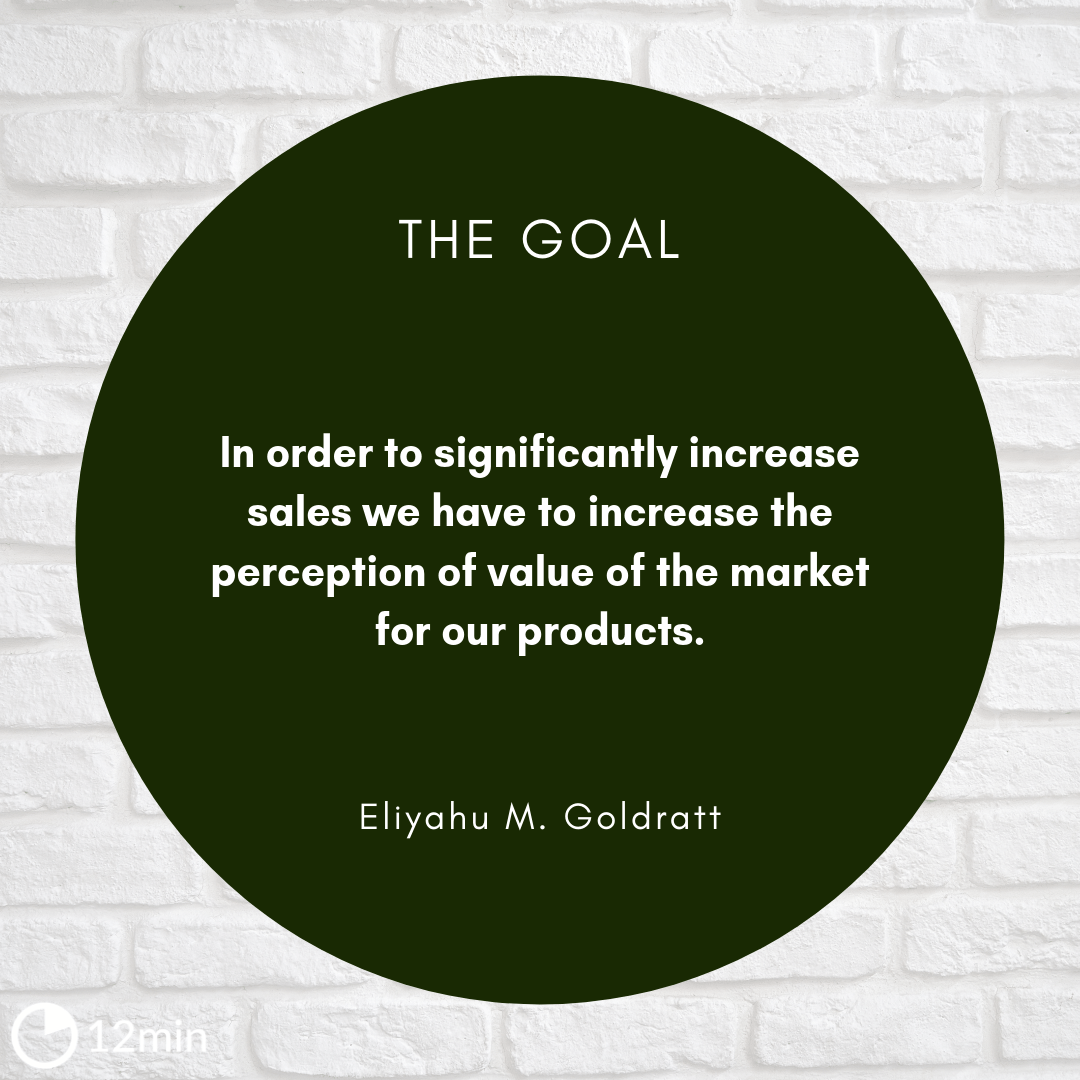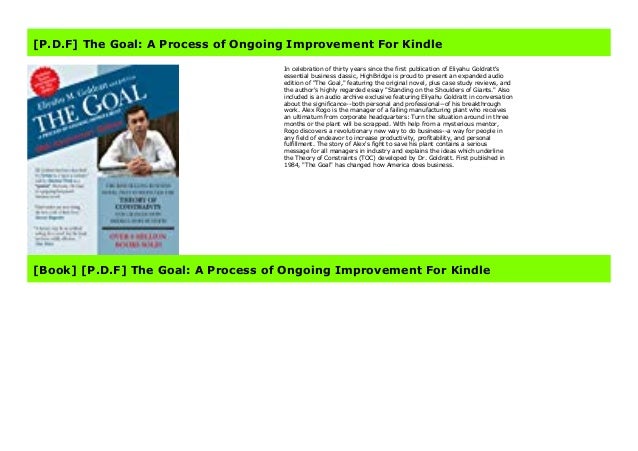With your goal in mind, identify the constraints within your system (i.e. Bottlenecks) and focus on improving the output of that constraint without worrying about the productivity of all related processes. The Goal summary. This is my book summary of The Goal by Eliyahu Goldratt.
- The Goal By Eliyahu Goldratt Pdf Full Book
- The Goal Free Pdf
- The Goal By Eliyahu Goldratt Pdf Free
- The Goal Summary Pdf
Even so, Goldratt continued writing business books and building on his Theory of Constraints that he introduced in The Goal. He formed research and consulting groups, and he developed several more influential manufacturing management concepts such as Thinking Processes, the Drum-Buffer-Rope method, and Critical Chain Project Management. This chapter introduces the main character Mr. Alex Rogo, an industrial engineer and an MBA. Goldratt. The Theory of constraints was developed and popularized by manufacturing guru Eliyahu M. Goldratt in 1984. Most people are first exposed to the concepts through his book The Goal. In 1986 Eliyahu Goldratt formed the Avraham Y. Goldratt Institute. This institute was formed to inform people about TOC (The Theory of Constraints). Download The Goal Eliyahu Goldratt Pdf Veltab - Goldratt, Eliyahu M, 1948- The goal: a process of ongoing improvement I Coxjeff, 1951- II Title PR9516 86 ISBN: 0-88427-178-1 Captured by Plamen T INTRODUCTION The Goal is about science and education I believe that these two words have been abused to the extent that their.
“So this is the goal: To make money by increasing net profit, while simultaneously increasing return on investment, and simultaneously increasing cash flow.”
Rating: 9/10
Related:
Short Summary
The Goal by Eliyahu Goldratt will fundamentally change the way you think about business and operations. A great book to learn how to properly analyze and optimize systems.
[thrive_leads id=’1462′]
The Goal: Executive Summary
The three areas where you should focus:

- Throughput: the rate at which the system generates money through sales. The money coming in
- Inventory: all the money that the system has invested in purchasing things which it intends to sell. The money inside the system
- Operational Expense: all the money the system spends in order to turn inventory into throughput. The money you pay to make throughput happen
The Goal:increase throughput while simultaneously reducing both inventory and operating expense
The system only moves as fast as the bottleneck.

To increase the capacity is to increase the capacity of ONLY the bottlenecks.
An hour lost on the bottleneck is lost forever.
The Goal By Eliyahu Goldratt Pdf Full Book
How to optimize a system:
- IDENTIFY the system’s constraint
- Decide how to EXPLOIT the system’s constraint
- SUBORDINATE everything else to the above decision
- ELEVATE the system’s constraint
- If in the previous steps a constraint has been broken, go back to step 1, but do not allow INERTIA to cause a system’s constraint
The Goal
The goal of any organization is to make money. Download adobe fireworks cs5.
Actions that move you towards making money are productive; actions that take away from making money are non-productive.
The Goal: to make money by increasing net profit, while simultaneously increasing return on investment, and simultaneously increasing cash flow
To translate the goal of making money to the day-to-day activities, focus on three measurements:
- Throughput: the rate at which the system generates money through sales. The money coming in
- Inventory: all the money that the system has invested in purchasing things which it intends to sell. The money inside the system
- Operational Expense: all the money the system spends in order to turn inventory into throughput. The money you have to pay out to make throughput happen
Reframing the Goal: increase throughput while simultaneously reducing both inventory and operating expense
“The goal is not to improve one measurement in isolation. The goal is to reduce operational expense and reduce inventory while simultaneously increasing throughput.”
The Bottleneck

The closer you are to a balanced plant — where the capacity of each and every resource is balanced exactly with demand from the market — the closer you are to bankruptcy.

If you are working at full capacity, throughput goes down while inventory goes up, which is inefficient. You can’t have a “balanced plant” without doing excess work.
Dependent Events: an event, or a series of events, that must take place before another can begin
Statistical Fluctuations: information we cannot precisely predict, like how long it will take the waiter to bring us our check
When dependent events are in combination statistical fluctuations you’ll develop bottlenecks in your system.
Bottlenecks: any resource whose capacity is equal to or less than the demand placed upon it. In turn, a non-bottleneck is any resource whose capacity is greater than the demand placed on it
The whole system only moves as fast as the bottleneck. To optimize it, you need to increase the bottleneck’s capacity and tie the rest of the system’s rate to the rate of the bottleneck.
How do you know if you have a bottleneck? First, look and see what has a big pile of work in front of it. Then find if the number of available hours for production for the resource is equal to or less than the hours demanded.
“To increase the capacity of the plant is to increase the capacity of only the bottlenecks.’’
Optimizing a System
To optimize the system, make the flow through the bottleneck equal to the demand from the market (or even a bit less).
The actual cost of a bottleneck is the total expense of the system divided by the number of hours the bottleneck produces.
If you lose one hour on the bottleneck, you’ve lost it forever.
The Goal Free Pdf
Make sure it’s time isn’t wasted on the bottleneck by:
- Sitting idle during a break
- Spending time on parts that are or will become defective
- Making it work on parts you don’t need
There are two ways to increase the capacity of the bottlenecks:
- Make them work only on what will contribute to throughput today
- Take some of the load off the bottlenecks and give it to non-bottlenecks
By making bottlenecks more productive, you increase your throughput and inventory declines. But you also put more demand on the other work centers. If the demand in another work center has gone above one hundred percent, then you’ve created a new bottleneck.
“When you make a non-bottleneck do more work than the bottleneck, you are not increasing productivity. On the contrary, you are doing exactly the opposite. You are creating excess inventory, which is against the goal.’’
If you reduce batch sizes, you reduce inventories as well as the amount of cash tied up at any one time, easing the pressure on cash flow. You’ll reduce the time it takes to process a batch, condensing the total lead time.
The Optimizing Process
The Goal By Eliyahu Goldratt Pdf Free
The rule you need to follow is to balance the flow with demand, not the capacity.
“Everywhere, improvement was interpreted as almost synonymous to cost savings. People are concentrating on reducing operating expenses as if it’s the most important measurement. But the important thing is that we, in our plant, have switched to regard throughput as the most important measurement. Improvement for us is not so much to reduce costs but to increase throughput.’’
The process to optimize a system has five steps:
- IDENTIFY the system’s constraint
- Decide how to EXPLOIT the system’s constraint
- SUBORDINATE everything else to the above decision
- ELEVATE the system’s constraint
- If in the previous steps a constraint has been broken, go back to step 1, but do not allow INERTIA to cause a system’s constraint

“Whenever the constraint is broken it changes conditions to the extent that it is very dangerous to extrapolate from the past.’ Even the things that we put in place in order to elevate the constraint must be reexamined.’’
To become a better manager, use first principles and search for the answers to three questions:
The Goal Summary Pdf
- What to change?
- What to change to?
- How to cause the change?
